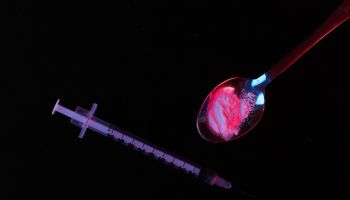Written by Kimberley Stakal
We can talk all day about “eating in moderation,” but if what we’re eating in moderation consists of various foods that are nothing more than processed, bleached, preserved and sugared ingredients, we might as well just call it what it is: Gradual toxic food poisoning. If your diet consists of little more than fast food, fried chicken, candy and boxed snacks, you could be on the path to become the one in three Americans obese today, or the one in five suffering from heart disease. Based on recurring scientific studies showing their toxicity to our health, here are five foods you should stop consuming today.
Soda
There can’t be enough to say about soda. It’s a recipe for disease disguised in a delicious, bubbly brew. We’ll just breeze on down the line with the ingredients found in a traditional, mainstream soda. Sodium benzoate is a preservative found in soft drinks, and it’s been linked to the phantom triad of allergies, asthma and eczema. Phosphoric acid, the chemical that gives soda its wonderfully sharp, brassy flavor, has been shown to cause osteoporosis and tooth decay (causing more damage to the bones than battery acid, some experts claim). This acid — yes, acid — depletes calcium and other minerals from the body as it’s excreted in urine, taking with it the very stuff our bones and teeth are made of. Because of the high amount of minerals it takes with it out of the body, phosphoric acid also does a number on the kidneys, and it’s linked to kidney and renal problems in drinkers. Most mainstream sodas are still sweetened with high fructose corn syrup, a sweetener that’s come under much scrutiny in recent years, with links to metabolic syndrome, obesity, diabetes and heart disease. For soda manufacturers going back to “natural cane sugar,” consumers should note that the sugars are still in such high quantities in sodas that they still lead to cavities, tooth decay and obesity. In fact, it’s estimated that regular soda drinkers are a whopping 80% more likely to develop type 2 diabetes than non-drinkers. Pass the water, please.
Fried Foods
There’s been a great deal of hard research (and backlashing controversy from the food industry) over the health effects of fried foods. Various studies around the world have found correlations between fried foods — particularly meats — and the prevalence of cancers developing in the body. While many studies have been deemed “inconclusive,” a very interesting and recent study in 2010 concluded that well-done meats, especially fried meats, doubled a person’s risks for developing bladder cancer compared to those eating meat rare or underdone. The lead author of the study, Professor Xifeng Wu, was reported to state, “These results strongly support what we suspected — people who eat a lot of red meat, particularly well-done red meat, such as fried or barbecued, seem to have a higher likelihood of bladder cancer.” Interestingly enough, fried foods have also been shown in scientific studies to increase the prevalence of asthma in patients.
Fast Food
Fast food contains so little actual food that it may as well be called “fast edibles.” Yes, it’s edible, alright; we can push it through our gullets and eventually pop it out in the end, but does that qualify it as food? Funny thing about food; it should feed the body (i.e. nourish it in some way). Fast food does anything but nourish; more appropriately, it merely shuts the body up until the next feeding time. For starters, fast food is ridiculously high in fat, calories and sodium. In one study, the average meal purchased by fast food customers surveyed was 827 calories. For those needing a reminder, the average adult needs only 1,800 to 2,000 calories in a full day. That 827-calorie meal is about half the calories most adults need in a day all at once; leaving little room for breakfast, dinner, snacks, dessert and any other foods that actually provide essential nutrients (whole grains, vegetables, fruits and lean protein).
But if you’re not a calorie counter, perhaps you care that fast food is laden with artificial ingredients (what’s fried chicken made of? Hint: It’s not chicken) and preservatives. Take McDonald’s scrambled eggs, for example. They’re just eggs, right? Sure, if by “just eggs” you’re also including sodium acid pyrophosphate, citric acid, monosodium phosphate and nisin (all preservatives), as well as liquid margarine (which is made from liquid soybean oil, water, partially hydrogenated cottonseed and soybean oils [trans fats], salt, hydrogenated cottonseed oil [trans fats], soy lecithin, mono- and diglycerides, sodium benzoate, potassium sorbate [preservatives], artificial flavor, citric acid, vitamin A palmitate and beta carotene [color]). In addition to the copious amounts of preservatives and trans fats in fast food, most chains still rely heavily on monosodium glutamate for the primary seasoning ingredient. While the food industry still tries to rebuff claims that MSG causes migraines, tremors and neurological disorders, organizations like the Mayo Clinic are finally stepping up to verify some of the very legitimate medical warnings for consumers.
White Flour Products
You know to eat your whole grains. But are you still buying Wonderbread for ham sandwiches, dining out for pasta twice a week and indulging in the ever-comforting macaroni and cheese at home? White flour is one of our generation’s most dangerous processed foods. We’ve taken something wholesome and nourishing (the whole grain) and refined it into something nearly unidentifiable to the body, then treated it with chemicals, deodorizers and bleaching agents.
When flour begins its processing journey, it’s a whole grain consisting of germ, bran and endosperm. To refine the grain, the germ and bran are stripped off, and most of the fiber, minerals and essential nutrients come off in the process. This refined grain leads to rapid release of insulin from the body when consumed, which leads to an overworked pancreas and an increased storage of fat (leading to both diabetes and obesity). But there are also the bleaching and deodorizing processes that most flour will go through before becoming “white flour.” If the idea of your food being treated with chlorine bleach freaks you out, don’t worry; it freaks us out, too. And a by-product of this process is a chemical called alloxan that forms in the flour, which has been linked to failure of the pancreas, a failure to produce insulin and the development of type 2 diabetes.
Baked Goods
I’ll take a beating for this one, but I’m going there anyways. Most commercially-prepared baked goods are just as bad for you as the aforementioned four “foods,” as they contain a number of the same toxins but in the guise of sweet muffins, flaky croissants and buttery muffins. Fast food chains and grocery chain bakeries use roughly the same heap of ingredients for baked treats: Margarines and processed vegetable oils; white flours; refined sugars; and heavy amounts of preservatives and additives. Sound like the same recipe for disaster as with soda, fast food and white bread? It is.
To give commercial baked goods their “buttery, flaky” texture, most are prepared with margarine or processed vegetable oils, which translate into trans fats, those fats we now understand to lead to heart disease and compromised cholesterol levels. Virtually all baked goods are made with white flours (see above for reasons to avoid this food). Those that are labeled as “made with whole grains” must be scrutinized very carefully to see if only 100% whole grains are used or (as in most cases) there are whole grains somewhere in the general long list of ingredients, but while flour still reigns conductor of that muffin train. Furthermore, baked goods are invariably loaded with sugars — usually bleached, refined white sugar. There’s a great read in the New York Times in which the author explores the idea that all sugar is toxic, in any amount, to the body — highly recommended food for thought. And while some fast food and coffee chains have introduced lines of “mini” baked goods for the health-conscious consumer, these foods are still produced with a grocery list of ingredients most of us can’t pronounce. Here’s one ingredients listing from a popular coffee chain’s piece of pound cake: Sugar, wheat flour, bleached, enriched (wheat flour, niacin, reduced iron, thiamine mononitrate, riboflavin and folic acid), egg, unsalted butter (pasteurized cream [from milk]), powdered sugar (sugar, cornstarch), water, lemon juice (lemon juice from concentrate [water, concentrated lemon juice], sodium benzoate, sodium metabisulfate and sodium sulfite [preservatives], lemon oil), vegetable shortening (palm and canola oil), emulsifier (propylene esters, mono- and diglycerides, sodium stearoyl lactylate, tricalcium phosphate), nonfat milk, baking powder (sodium acid pyrophosphate, sodium bicarbonate, corn starch, monocalcium phosphate), food starch – modified, natural flavor, salt, icing base (dextrose, stearic acid, agar agar, salt, pectin, guar gum, sodium hexametaphosphate), corn syrup, natural butter flavor (maltodextrin, natural butter flavor, annatto and turmeric [for color]), vital wheat gluten, guar gum, xanthan gum, natural lemon oil, beta carotene wsp (maltodextrin, glucose syrup, gum arabic, vegetable oil, tocopherol, vitamin c, beta carotene pure, silicon dioxide), titanium dioxide. may contain pan spray (canola oil, soy lecithin, may contain mineral oil, and/or natural flavor). Hello! Have you made it to this point in the paragraph? Congratulations, you’ve just reached the end of the ingredients. You’ve earned your slice of cake. Right.
Folks, the choice is yours. We can eat whatever we want in moderation with the hopes that we’re eating just less than enough poison to make our body terminally diseased, and tell ourselves that a bit of spinach with dinner will make all the bad stuff go away. Or we can at least acknowledge that certain foods, in any amount, are slowly doing a disservice to our bodies, and rather than fitting into a “balanced” diet, they’re merely small imbalances that, bit by bit, cause our internal structures to become fully imbalanced. My personal conclusion is simple: Eat well, live well.
http://www.huffingtonpost.com/organic-authoritycom/5-foods-to-stop-eating-to_b_967117.html
Article Courtesy of The Huffington Post
















